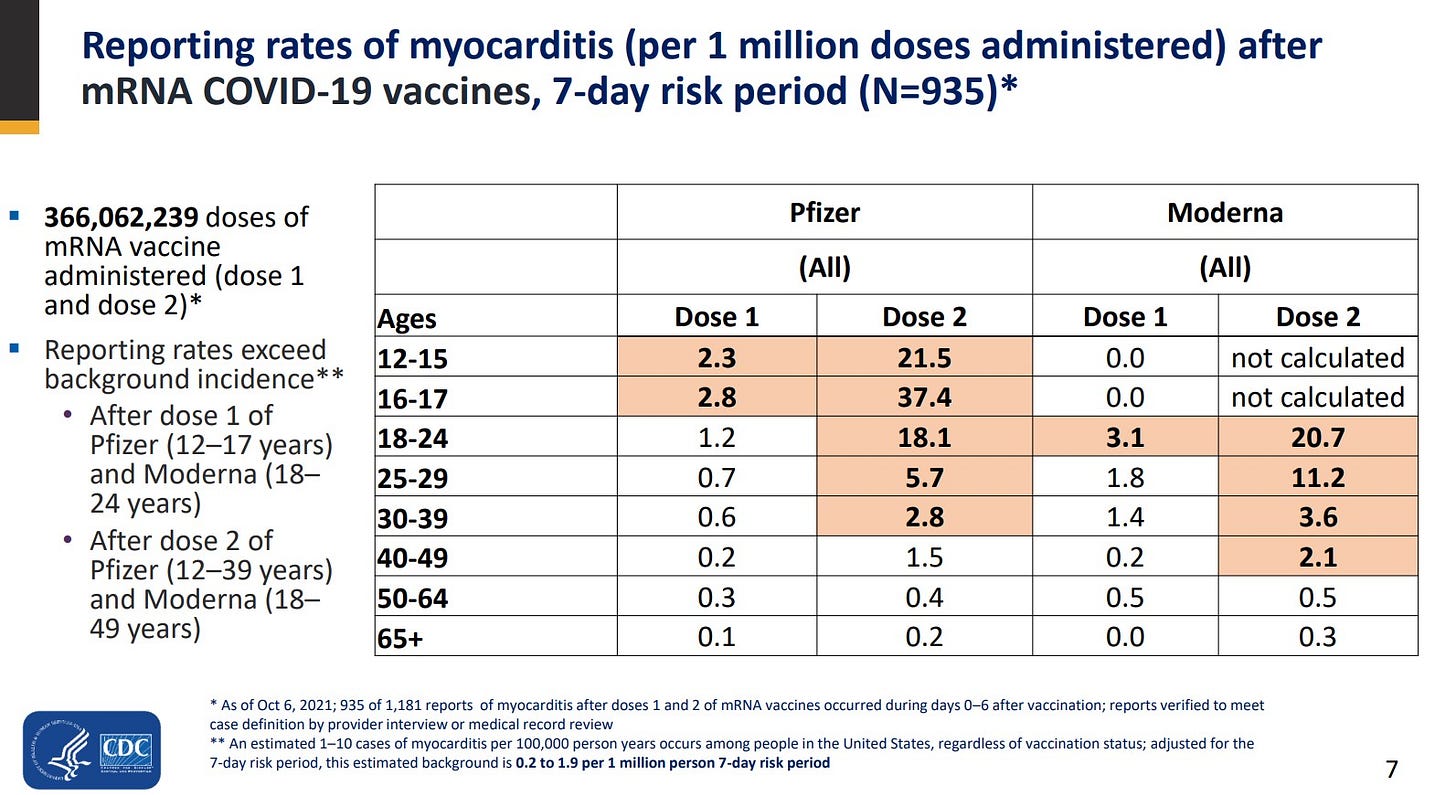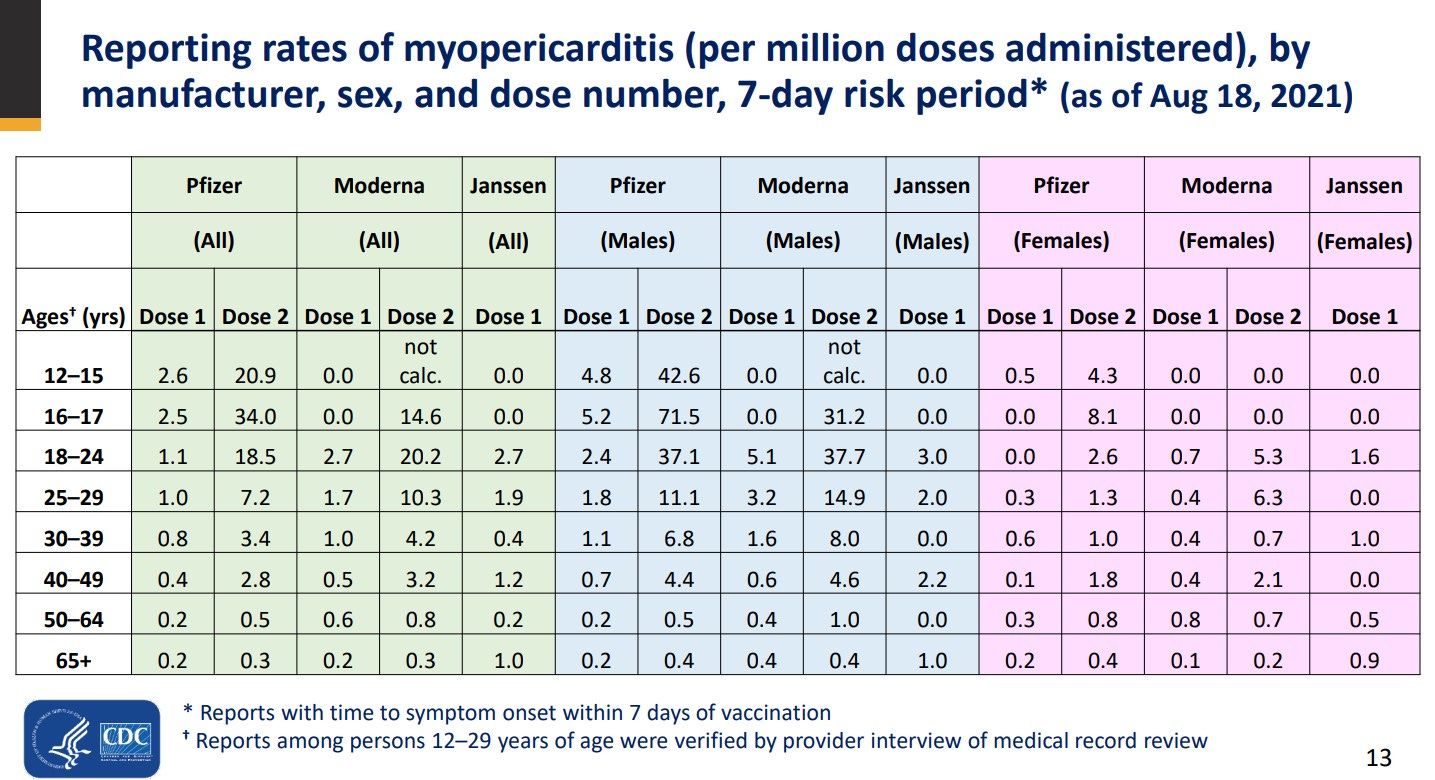Something is rotten in Denmark. I am referring, more specifically, to the Danish study that claims to show that the risk of myocarditis is 3-4 times higher for the Moderna Covid-19 vaccine than for Pfizer-BioNTech and that was being widely cited, following a Reuters report, before Christmas.
But look at the abstract of the study here. The study actually claims that there is no statistically significant increased risk of myocarditis associated with Pfizer-BioNTech (BNT162b2) among men at all! There is only, according to the authors, increased risk among women.
Well, this makes the Danish study an outlier if there ever was one. Increased risk of myocarditis especially for young men is officially acknowledged in both the US and Europe for both mRNA vaccines: Moderna and Pfizer-BioNTech.
Moreover, the claim that men incur no increased risk of myocarditis associated with the Pfizer-BioNTech vaccine should cause severe cognitive dissonance for anyone who has followed the flood of "anecdotal" testimonials on social media from men reporting having suffered myocarditis after inoculation with the Pfizer-BioNTech vaccine.
Of course, it is difficult to quantify such reports or to use them as the basis for comparisons, especially since social media platforms and/or group moderators have made a regular practice of suppressing them. But, fortunately, we also have the data of the US Vaccine Adverse Events Reporting System (VAERS).
Jessica Rose and Peter McCullough's September 2021 paper on myocarditis reports in VAERS, which was famously or infamously "removed" without explanation by the publisher Elsevier, found that fully 67% of the reported cases of myocarditis in VAERS at the time of writing were associated with Pfizer-BioNTech. Now, this does not tell us anything about the per dose incidence, and even at that time Pfizer-BioNTech was being used somewhat more than Moderna in the US and in certain age groups exclusively.
But the CDC has also provided data on per dose incidence. See below for the data up to October 6, 2021.
Note that the data reveals very little difference in the overall (Dose 1 + Dose 2) incidence of myocarditis for Pfizer and Moderna other than in the anomalous 25-29 age group, which shows roughly two times greater incidence for Moderna. Most of the age groups show a somewhat greater incidence for Moderna. But it should be recalled that the effectiveness of the Moderna vaccine has, on the other hand, been repeatedly shown to be more long-lasting than that of Pfizer-BioNTech: in this Swedish study, for instance, it was twice as great after 6 months. (And after 7 months, Pfizer-BioNTech had no effectiveness!) Both phenomena are presumably linked to Moderna's higher dosage.
It is also interesting to look at the same data (here also broken down by sex) up to August 13, 2021.
Note that this earlier presentation of the data also still included the Johnson & Johnson (Janssen) vaccine and showed that the single dose J & J vaccine exhibited virtually no increased incidence of myocarditis over the background rate. The CDC recently recommended against the use of the Johnson & Johnson vaccine due to a total of 54 cases of thrombosis associated with the vaccine, most of them involving younger women. As of July 8, 2021 (see below), the CDC found there to be a maximum thrombosis reporting rate associated with J & J of almost 9 per million among women in the 30-49 age group. The reporting rate was less than half this in all other age groups.
But, for some reason, the comparable or, in certain age groups, far higher reported incidence of myocarditis associated with Pfizer-BioNTech (and, of course, Moderna) for younger men appears not to pose a problem. As Jean Rees has asked, in noting a similar double-standard in the CDC's response to vaccine-induced adverse events, "Is this remotely scientific?"
Given that virtually all observers, other than the current incarnation of the US government, recognize that adverse events are underreported in the VAERS system, we need, moreover, to multiply the reporting rates by some factor to get a realistic picture of the extent of the problem of vaccine-induced myocarditis. Steve Kirsch suggests using an "underreporting factor" of 41 and he insists that this is a conservative estimate. A recent study by Spiro Pantazatos and Herve Seligmann concluded that the VAERS underreporting factor was at least 20. Let us be even more conservative and use a factor of just 10.
The reported incidence of myocarditis for Pfizer-BioNTech in the 16-17 age group in the first CDC table above is roughly 40 per million. For comparison’s sake, this is more than 20 times greater than the maximum background rate cited by the CDC (“0.2 to 1.9 per million”). 40 per million corresponds to a rate of 1 case of myocarditis per 25,000 vaccinations.1 But if we multiply by a factor of ten, we obtain rather 400 per million – more than 200 times greater than the maximum background rate – corresponding to a rate of 1 myocarditis per 2500 vaccinations.
And remember this is an aggregate rate including both young men and young women. For almost all observers, including the CDC – and other apparently than the Danish researchers – the rate for young men should be considerably higher. So, let us look at the latest (October) data just for males.
The reported incidence of myocarditis for Pfizer-BioNTech specifically for males in the 16-17 age group is roughly 75 per million: almost twice the aggregate rate. Let us do the same calculation undertaken above. Multiplying by an underreporting factor of 10 gives 750 per million – more than 375 times the CDC’s maximum background rate. This corresponds to 1 case of myocarditis per 1333 vaccinations. If we use Kirsch's suggested underreporting factor of 41, the rate would be around 1 per 325.
Implausible? Well, consider the curious case of the Acrog-Tormans cycling team of the Belgian region of Flanders. In mid-August, the Flemish paper Het Laatste Nieuws reported that one of the up-and-coming stars of the team's junior squad, Yarno Van Herck, had developed heart problems during a race and been diagnosed with myocarditis. Van Herck had his first shot of the Pfizer-BioNTech vaccine two days before the race. Two other members of the junior squad, Joppe Erpels and Xander Verhagen, also developed heart problems shortly after being vaccinated. Erpels' reaction was so severe that he had to be admitted to intensive care. All 80 members of the junior squad, consisting of cyclists between the ages of 15 and 17, had been vaccinated in the prior weeks. So, three out of 80 gives a rate of more than 1 out of 27!
Just how the Danish study managed to find no signal whatsoever of an increased risk of myocarditis for men associated with the Pfizer-BioNTech vaccine is anybody's guess. Some analyses of the VAERS data suggest that the great bulk of adverse events are concentrated in just a relatively few lots of the vaccines. Perhaps Denmark, a country of only 5.8 million people, has been lucky enough to receive innocuous lots. But this would still not explain why there was indeed a signal of increased risk for women. In any event, with all due respect to small countries, 330 million Americans surely provide a more representative sample, and the raw VAERS data – not to mention the first-hand testimonials of legions of young men around the world – tell a very different story.
(P.S. Since I completed the first draft of this essay, a second, perhaps even more widely-cited, European study has been published that appears to show a much higher myocarditis risk associated with Moderna than Pfizer-BioNTech: namely, the “Oxford” study of Julia Hippisley-Cox et al. The underlying data on which the study is based appears not to be publicly available. Although perhaps not containing any “smoking gun” that calls into question its representativeness, as in the Danish study, two points about this study are worth quickly mentioning. Firstly, there is indeed a significant anomaly also in this study: namely, the fact that the AstraZeneca Covid-19 vaccine, which does not use mRNA technology, is found to be associated with a higher myocarditis risk after 2nd dose than the Pfizer-BioNTech vaccine. The non-mRNA, viral vector, Covid-19 vaccines (AstraZeneca and Johnson & Johnson) are not known to be associated with a myocarditis risk. Secondly, although 67 million Britons certainly allow for a more substantial sample than 5.8 million Danes, the fact of the matter is that Moderna is hardly used in the United Kingdom. Indeed the sample size for Pfizer-BioNTech in the Oxford study is more than 17 times greater than the sample size for Moderna. In any case, the Oxford study still raises the same problem as the Danish one: How is the discrepancy between the study’s findings and the raw, publicly available, US data to be explained? Either there is something wrong with the study or there is something wrong with the US data or there is something seriously wrong with the standardization of the vaccines.)
Here and in what follows I will be making the obviously counterfactual assumption that all vaccinees complete a full 2-dose schedule. This is obviously counterfactual precisely because of adverse events and the fact that some people who suffer them after the first dose will not return for the second. But (a) since severe adverse events in general and myocarditis in particular are far more likely after the second dose, this will not distort the overall picture much and (b) the alternate procedure, i.e. relating the numerator of adverse events to the denominator of total doses, here 2 million instead of 1, would obviously distort it massively. The recipients of dose 1 and dose 2 are, after all, the same people!







"Firstly, there is indeed a significant anomaly also in this study: namely, the fact that the AstraZeneca Covid-19 vaccine, which does not use mRNA technology, is found to be associated with a higher myocarditis risk after 2nd dose than the Pfizer-BioNTech vaccine."
Do you think there is a small chance the wrong vaccine was somehow added into the patient records?
I recently saw Prof Norman Fenton on the DarkHorse podcast, and he mentioned how the nurse administered Pfizer even though he thought he was going to get AstraZeneca.
https://youtu.be/-PRefQ2o6QI?t=4344
The other reason I find this odd is that after watching that video, I have been trying to find out exactly how many doses of each vaccine was administered in the UK and I have had no luck finding a definitive source.